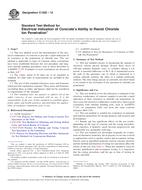Wir benötigen Ihre Einwilligung zur Verwendung der einzelnen Daten, damit Sie unter anderem Informationen zu Ihren Interessen einsehen können. Klicken Sie auf "OK", um Ihre Zustimmung zu erteilen.
ASTM C1202-12
Standard Test Method for Electrical Indication of Concrete´s Ability to Resist Chloride Ion Penetration
Automatische name übersetzung:
Standard Test Method for Electrical Anzeige Betons Fähigkeit, Chloridionen Penetration Wider
NORM herausgegeben am 1.2.2012
Informationen über die Norm:
Bezeichnung normen: ASTM C1202-12
Anmerkung: UNGÜLTIG
Ausgabedatum normen: 1.2.2012
SKU: NS-10018
Zahl der Seiten: 8
Gewicht ca.: 24 g (0.05 Pfund)
Land: Amerikanische technische Norm
Kategorie: Technische Normen ASTM
Kategorie - ähnliche Normen:
Die Annotation des Normtextes ASTM C1202-12 :
Keywords:
chloride content, corrosion, deicing chemicals, resistance-chloride penetration, ICS Number Code 91.100.30 (Concrete and concrete products)
Ergänzende Informationen
| Significance and Use | ||||||||||
|
This test method covers the laboratory evaluation of the electrical conductance of concrete samples to provide a rapid indication of their resistance to chloride ion penetration. In most cases the electrical conductance results have shown good correlation with chloride ponding tests, such as AASHTO T259, on companion slabs cast from the same concrete mixtures (Refs 1-5). This test method is suitable for evaluation of materials and material proportions for design purposes and research and development. Sample age has significant effects on the test results, depending on the type of concrete and the curing procedure. Most concretes, if properly cured, become progressively and significantly less permeable with time. This test method was developed originally for evaluations of alternative materials, but in practice its use has evolved to applications such as quality control and acceptance testing. Factors such as ingredient materials used in concrete mixtures and the method and duration of curing test specimens affect the results of this test (See Note 1). When this method is used for mixture qualification and acceptance testing, it is imperative that the curing procedures and the age at time of testing be clearly specified. Note 1—When using this test for determining acceptability of concrete mixtures, statistically-based criteria and test age for prequalification, or for acceptance based on jobsite samples, should be stated in project specifications. Acceptance criteria for this test should consider the sources of variability affecting the results and ensure balanced risk between supplier and purchaser. The anticipated exposure conditions and time before a structure will be put into service should be considered. One approach to establishing criteria is discussed in Ref 6. Table X1.1 in Appendix X1 provides a qualitative relationship between the results of this test and the chloride ion penetrability of concrete. Care should be taken in interpreting results of this test when it is used on surface-treated concretes, for example, concretes treated with penetrating sealers. The results from this test on some such concretes indicate low resistance to chloride ion penetration, while 90-day chloride ponding tests on companion slabs show a higher resistance. The details of the test method apply to 100-mm nominal diameter specimens. This includes specimens with actual diameters ranging from 95 to 100 mm. Other specimen diameters may be tested with appropriate changes in the applied voltage cell design (see 7.5 and Fig. 1). For specimen diameters other than 95 mm, the test result value for total charge passed must be adjusted following the procedure in 11.2. For specimens with diameters less than 95 mm, particular care must be taken in coating and mounting the specimens to ensure that the conductive solutions are able to contact the entire end areas during the test.
|
||||||||||
| 1. Scope | ||||||||||
|
1.1 This test method covers the determination of the electrical conductance of concrete to provide a rapid indication of its resistance to the penetration of chloride ions. This test method is applicable to types of concrete where correlations have been established between this test procedure and long-term chloride ponding procedures such as those described in AASHTO T 259. Examples of such correlations are discussed in Refs 1-5. 1.2 The values stated in SI units are to be regarded as standard. No other units of measurement are included in this standard. 1.3 The text of this standard references notes and footnotes which provide explanatory material. These notes and footnotes (excluding those in tables and figures) shall not be considered as requirements of the standard. 1.4 This standard does not purport to address all of the safety concerns, if any, associated with its use. It is the responsibility of the user of this standard to establish appropriate safety and health practices and determine the applicability of regulatory limitations prior to use. ^REFERENCE: ASTM Standards: C31/C31M Practice for Making and Curing Concrete Test Specimens in the Field C42/C42M Test Method for Obtaining and Testing Drilled Cores and Sawed Beams of Concrete C192/C192M Practice for Making and Curing Concrete Test Specimens in the Laboratory C670 Practice for Preparing Precision and Bias Statements for Test Methods for Construction Materials AASHTO Standard: T 259 Method of Test for Resistance of Concrete to Chloride Ion Penetration |
||||||||||
| 2. Referenced Documents | ||||||||||
|
Ähnliche Normen:
Historisch
1.6.2006
Historisch
1.5.2010
Historisch
1.10.2011
Historisch
1.6.2014
Historisch
1.6.2011
Historisch
1.8.2008



 ASTM D6532-00(2006)..
ASTM D6532-00(2006).. ASTM D6884-03(2010)..
ASTM D6884-03(2010).. ASTM D6916-06c(2011)..
ASTM D6916-06c(2011).. ASTM D7172-14
ASTM D7172-14 ASTM D7174-05(2011)..
ASTM D7174-05(2011).. ASTM D7276-08
ASTM D7276-08 Cookies
Cookies
